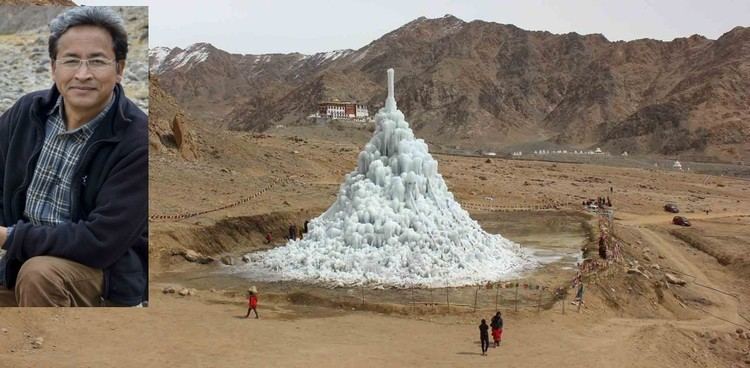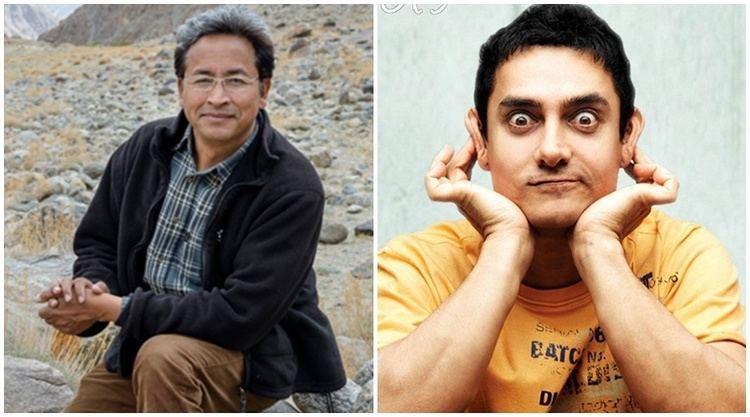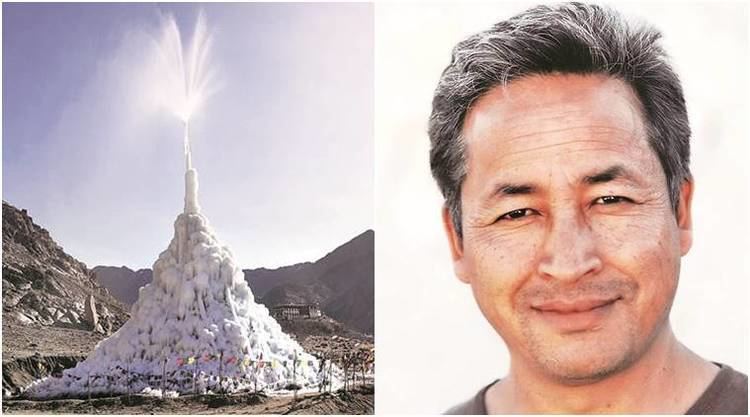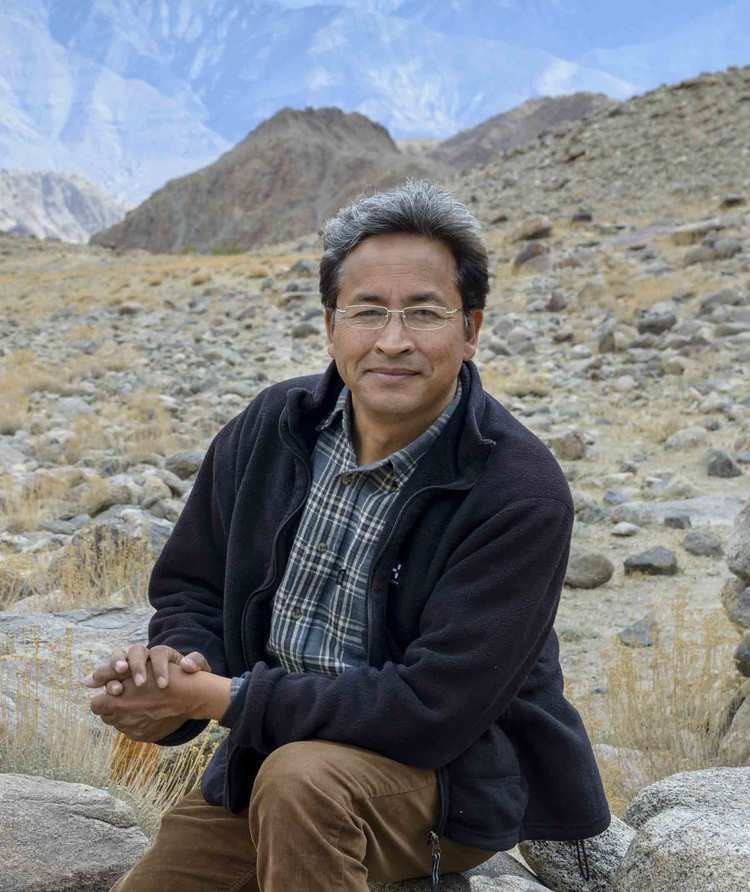Parents Sonam Wangyal | ||
 | ||
Education | ||
Sonam Wangchuk (born on September 1, 1966 at UleyTokpo, near Alchi, in the Trans Himalayan region of Ladakh, India) is an engineer, innovator, and an education reformist. He is the Founding Director of the Students’ Educational and Cultural Movement of Ladakh (SECMOL) which was founded in 1988 by a group of students who had been in his own words, the ‘victims’ of an alien education system foisted on Ladakh. SECMOL strives to rebuild the lost pride and self-confidence of the students of Ladakh through its educational reforms programme. He is also known for designing the SECMOL campus that runs completely on solar energy and uses no fossil fuels for cooking, lighting or heating, even in Ladakhi winters when temperatures fall to minus 25C degrees.
Contents

Wangchuk was instrumental in the launch of Operation New Hope in 1994, a triangular collaboration of government, village communities and the civil society to bring reforms in the government schools system. This movement led to raising the all important 10th grade exam results in the region from 5% success to eventually 75%.

Early life
Sonam Wangchuk was born in 1966 in a tiny village of 5 households called UleyTokpo, near Alchi in 1966. Because of this, he was not enrolled in a school until the age of 8.5 yrs. His mother taught him all the basics in his own mother tongue till that age. His uncle Abdul Hamid, who was a Muslim by faith, took him to the remote region of Nubra where he was enrolled in two different schools in 6 months, where due to his maturity the teachers promoted him to his next class and when he returned to Leh after 6 months he was in grade 3 along with other 9 yrs old. Sonam often consider himself lucky to have been spared the pains of schooling in alien languages which other Ladakhi children were forced to. He considers his early years spent with his mother and learning from her reading and writing in his mother tongue along with freedom to explore nature and village life as the best education possible for himself. In those days, his father Sonam Wangyal, a politician who later became the minister in state government, was stationed in Srinagar. At age 9, he was taken to Srinagar and enrolled in a school there. Since he looked different compared to the other students, he would get addressed in a language that he did not understand. Due to which his lack of responsiveness was mistaken for him being stupid. He recalls this period as the darkest part of his life. Unable to bear the treatment, in 1977 he escaped alone to Delhi where he pleaded his case to the school principal at Vishesh Kendriya Vidyala. It was a free, residential, government-run school for children from the border areas of India, and he received enough encouragement from his teachers which let him come out of his shell. He studied well, participated in many extracurricular activities. In 1983, he got admission in the National Institute of Technology (then REC), Srinagar and completed his bachelor's degree in Mechanical Engineering in 1987.

Due to some differences with his father over the choice of engineering stream (he wanted to do mechanical while his father insisted in civil), he had to finance his own education. For this, he ran a coaching center for 10th grade students during his college vacation. The experience of seeing perfectly bright students struggling and failing in the examination made him interested in changing the education system "instead of adding another engineer to the crowd".
Career
The year after his graduation he started SECMOL, the Students Educational and Cultural Movement of Ladakh. After experimenting school reforms in government high school Saspol, SECMOL launched Operation New Hope in collaboration with the government education department and the village population. Since June 1993 till August 2005, he also founded and worked as the editor of Ladakh’s only print magazine Ladags Melong, which is one of the greatest sources of regional news and environmental issues.
In 2001, he was appointed to be an advisor for the education in the Hill Council Government. In 2002, together with other NGO heads, he founded Ladakh Voluntary Network (LVN), a network of Ladakhi NGOs, and served in its Executive committee as the Secretary till 2005.
In 2004, he was appointed to the Drafting Committee of the Ladakh Hill Council Government’s Vision Document ‘Ladakh 2025’ and entrusted with the formulation of the policy on Education and Tourism. The document was formally launched by Dr. Manmohan Singh, the Prime Minister of India in 2005. In 2005, he was appointed as a member in the National Governing Council for Elementary Education in the Ministry of Human Resource Development, Government of India.
From 2007-2010, Wangchuk worked as an Education Advisor for MS, a Danish NGO working to support the Nepalese Ministry of Education for Education Reforms. In 2009, he was invited by the Prime Minister of Bhutan to be in the international advisory group for introduction of Gross National Happiness in Education.
In 2011, he did his Masters Specialisation in Earthen Architecture from CRAterre, National School of Architecture, in Grenoble France.
In late 2013, he invented and built a prototype of the Ice Stupa which is an artificial glacier that stores the wasting stream waters during the winters in the form of giant ice cones or stupas, and releases the water during late spring as they start melting, which is the perfect time when the farmers need water.
In 2013, he was appointed to the Jammu & Kashmir State Education Advisory Board.
In 2014, he was appointed to the Expert panel for framing the J&K State Education Policy and Vision Document. Since 2015, Sonam has started working on establishing Himalayan Institute of Alternatives. He is concerned about how most of the Universities, especially those in the mountains have become irrelevant to realities of life.
Innovations
Sonam has been helping to design and oversee the construction of several passive solar mud buildings in mountain regions like Ladakh, Nepal, Sikkim so that energy savings principles are implemented on a larger scale, thus reducing fuel burden. Sonam’s experience shows how buildings play a great role in education and how solar mud buildings are more sustainable at different levels. Even in -30 Celsius winters, his solar-powered school built with the rammed earth keeps the students warm.
Led by Sonam, SECMOL has won the International Terra Award for best building in July, 2016 at the 12th World Congress on Earthen Architecture in Lyon, France. The rammed earth ‘Big Building’, located at SECMOL Campus, was built using simple, low-cost traditional techniques on principles of passive solar architecture. The building comprises a big solar heated teaching hall, along with several rooms for the students and other classrooms.
In January 2014, Sonam started a project called the Ice Stupa. His aim was to find a solution to the water crisis being faced by the farmers of Ladakh in the critical planting months of April and May before the natural glacial melt waters start flowing. By the end of February in 2014, they had successfully built a two-story prototype of an ice stupa which could store roughly 150,000 litres of winter stream water which nobody wanted at the time.
In 2015, when Ladakh faced a crisis due to a land slide which blocked the Phugtal river in Zanskar and caused formation of 15 km long lake which became a huge threat for the downstream population. While government agencies like NDMA were fumbling for solutions, he proposed to used siphon technique to drain the lake and water jet erosion to safely cut the edges instead of blasting the lake as was being planned. However, his advice was ignored and blasting work was carried on. On May 7, 2015, the lake finally burst into flash flood which destroyed 12 bridges and many fields.
In 2016, Sonam started applying ice stupa technique for disaster mitigation at high altitude glacier lakes. He was invited by Sikkim government to apply siphon technique for another dangerous lake in their state. In Sep 2016 he led a three weeks expedition to the Lhonak Glacial Lake in North-West Sikkim, which had been declared dangerous for the last few years. This lake at 5,200 m (17,000 feet) altitude located right next to the Tibet (China) border is accessed only by a full day of Jeep ride from Gangtok and then four days by trek over the high passes. His team camped in tents for two weeks at the lake amidst rain, snow and unreasonable weather, installing the first phase of a siphoning system to drain the lake to a safer level until other measures were taken up.
In late 2016, the idea started gaining intense traction from the authorities in the Swiss Alps. Sonam was invited by the president of Pontresina, a municipality in the Engadine valley near the winter sports resort town of St. Moritz, Switzerland to build ice stupas to add to their bouquet of winter tourism attractions. In Oct 2016, Sonam and his team went to the Swiss Alps and started building the first ice stupa of Europe together with the Swiss partners. After this prototype is built and tested, the Swiss also want to expand the project to build more ice stupas, mainly to counter the phenomenon of fast-melting glaciers in the upper reaches of the Swiss mountains.
Struggle
In 1988, a year after graduating as an engineer, Sonam, with his brother and five peers, formed the Students’ Educational and Cultural Movement of Ladakh (SECMOL). Their first fundraising effort, a Ladakhi cultural show, proved to be a huge success. Until 1990 Sonam coached school students and offered vocational training courses to dropouts. He felt compelled towards getting to the root of the problem, and he realized that the solution to that lies in localizing the system of elementary education. He always advocated strengthening the existing government school system where most children are enrolled rather than setting up parallel private school.
Since 1991, he started working towards the improvement of the village government schools. He first experimented in a small number of schools and later expanded it to the whole district. At this point the movement was named Operation New Hope, so that all governmental and non-governmental players can participate and feel the ownership of it. During this period they had their first collaboration with the state government and then with the Ladakh Autonomous Hill Development Council after its formation in 1995. His model was based on replacing 3 'R's of education Reading, writing & arithmetic with a more holistic 3 'H's of education – bright Head, skilled Hand & kind Heart.
After the 2007, he took up an education reform assignment as an advisor in Nepal for two years. For this he learnt the Nepalese language not only to speak but also to read and write within six months.
Post this he wanted to enhance his engineering knowledge and therefore he went for two years of higher studies in Earthen Architecture at CRAterre in Grenoble, France. For this he learned the French language 2 months prior to the course.
Politics
In 2013, on repeated requests from students community of Ladakh, Sonam helped launch a political party called New Ladakh Movement (NLM), which became the green party of Ladakh and had the aim of working for education, environment and economy. It also aimed at uniting all the political leaders under one banner for growth & development of Ladakh. However, they badly lost the elections of the Hill Council in Oct 2015.
